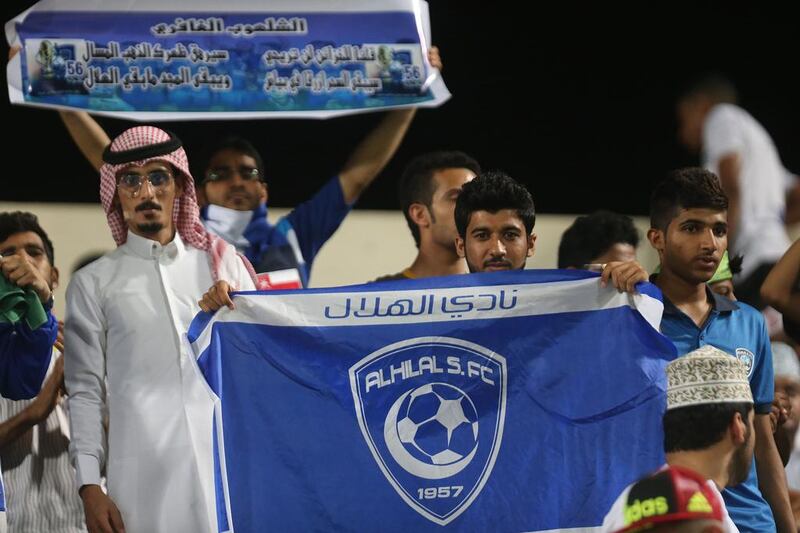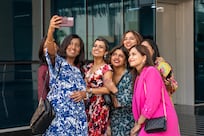On May 4, Al Hilal football club thumped city rivals Al Nassr by five goals to one, lifting their 14th domestic Saudi Professional league title.
As jubilant players celebrated, fans were entertained to a colourful display of fireworks and video montages of the club’s illustrious season. An ever-energetic, joyous crowd unable to attend the match welcomed the squad outside the King Fahd International Stadium as the latter rode an open top bus to the club headquarters.
Inscribed on their championship-marking T-shirt was a vivid reminder of the nation’s Vision 2030.
“… Our real wealth lies in the ambition of our people and the potential of our younger generation.”
That was a snippet of the speech by Saudi Arabia’s deputy crown prince Mohammed bin Salman, as he revealed the nation’s strategy to reduce dependency on oil and seek alternate means to be sustainable, in April 2016.
A week later, one of Saudi’s big four clubs – Al Nassr – floated the possibility of dropping its spot in the 17/18 edition of the Asian Champions League, Asia’s most coveted club tournament. The club’s reason was that it would not be able to apply for the Asian club licence – a requirement to participate in the competition – due to its inability to reduce debt by 100 million Saudi riyals (Dh97.9m), as required.
The new Vision will see Saudi Arabia move away from oil dependency towards a future that focuses on economic diversification, innovation and employment and creative self-fulfillment of its citizens.
It promotes multiple tenets aimed at guiding the move to a sustainable Saudi Arabia. One of those is the Fiscal Balance Programme, which focuses on developing a more effective government, with an emphasis on more efficient government spending. And at the core the importance is on the “happiness and fulfilment of citizens and residents. This can only be achieved through promoting physical, psychological and social well-being.”
To that point, regarding a sport that is popular nationwide, the Saudi people are paramount, according to Jan Van Winckel, the technical director at the Saudi Arabian Football Federation and an ex-assistant of the football coach Marcelo Bielsa at Olympique de Marseille in France.
“Saudi Vision 2030 is a great and ambitious project but what I really like is the emphasis on the Saudi people. Prince Mohammed bin Salman said that not oil or gold is the most important resource of Saudi but its people, the Saudi people. And I cannot agree more.
“You can only develop football in a country through the local people. That’s why we are focusing on developing the Saudi national coach. When I started 18 months ago, we only had 250 certified coaches. Now we are certifying through AFC [Asian Football Confederation] more than 1,000 new coaches every year. Not [just] me or my staff will develop football but all of the coaches together will transmit our ideas, our philosophy. And the vision that is transmitted is not my vision but the vision of the Saudi coaches. We took a survey and asked more than 200 Saudi coaches to complete it. Based on their responses we identified … the vision on how football in Saudi should be played and developed,” says Mr Van Winckel.
As part of governmental efforts to address that need to give its citizens a sense of fulfilment, funding will be increased for “Daem”, a national programme to enhance the quality of cultural activities and entertainment and identify local Saudi talent. This includes providing financial support to football clubs across the nation, encouraging them to not only operate primarily as a football club but also provide a platform for activities across multiple disciplines such as swimming, basketball and karate.
With football being the principal recipient of government sports funding, a master plan was drafted to better place Saudi Arabia at the forefront of regional football.
“The ‘Master Plan, Road To Qatar 2022’, which was developed by Prince Abdullah bin Mosaed, the former president of the GSA [General Sports Authority], focuses on four pillars. The development of the Saudi national teams, the development of local clubs, the development of the local coaches and the development of football of players starting from the age of six years old,” says Mr Van Winckel.
And the emphasis on the younger generation and the training programmes required is important, he says.
“Professional football players [overseas] train more than 10,000 hours throughout their development as youth player. Saudi football players and most football players in the [Arabian] Gulf do not even reach 5,000 hours. That is why we should start developing players from a younger age.”
Most, if not all, Saudi clubs have had their issues when it comes to financial stability, particularly those in the top division, the Saudi Professional League. They tend to be semi-government entities, funded by various princes and honorary members to keep operations ticking over.
In the past, and to a certain extent still, the majority of these clubs face or have faced financial issues stemming from unscrupulous player contracts. That has led to players not receiving salaries and Fifa-led injunctions, spiralling into backlog of payments due to players and staff, eventually accumulating as debt. Then the respective “well-wishers” with an affinity to their favourite clubs come in and bail them out.
While revenue from TV broadcast of the domestic league has helped – in 2014 the regional media conglomerate MBC Group paid about US$1.1 billion for TV rights for 10 years, the annual distribution of these funds along with those from league sponsors and game-day ticket sales are not enough to keep clubs financially stable.
Hence, Vision 2030 requires these clubs to start functioning as profitable businesses that rely less on support and donations. Interestingly enough, the concept of privatisation of the clubs is being introduced – a part of the general attempt to diversify the economy.
As part of this reform, the goal is to restructure the sports sector while developing a realistic plan; through a privatisation policy similar to that which has proved effective in other international markets. The majority of clubs abroad, particularly in Europe and Latin America, show how the concept can contribute in boosting local economies without burdening the state.
Last year, as the concept of privatisation of clubs participating in the Saudi Premier League was approved, the Council of Economic and Development Affairs (CEDA) also deemed it appropriate to empower the General Sports Authority (GSA) to grant licences to interested parties (firms). In February, the GSA appointed one of the nation’s largest privately owned investment banks – Jadwa Investments to advise on the matter. While the exact responsibility of the group is unclear, Jadwa is expected to make recommendations on potential suitors for five clubs initially, after studying the offers and conducting due-diligence. Sources close to the project suggest most of the investors are likely to be wealthy individuals with an affinity to their respective clubs. Separately, they had also directed the authority to create a Sports Development Fund, which will look into investment opportunities raising the profile of different sports.
At least $650 million was initially allocated to the fund to provide loans for clubs, support sports events and assist in privatisation – all of which is projected to create up to 40,000 jobs.
A stronger focus was placed on protecting the brand and intellectual property of the clubs. Three months after the reforms were announced, the General Sports Authority and the ministry of commerce and investment launched a campaign to raise awareness among sports clubs across various disciplines on the significance of registering trademarks, identifying lost revenue and protecting brands from counterfeits.
These reforms, in sport at least, are critical in Saudi Arabia, and could prove positive not just for the nation’s economy and its football but also for the region. The immediate impact of the overhaul is positive, says Mr Van Winckel.
“We have doubled the number of active football clubs, we have doubled the number of registered players in only a year. And, more important, we have restored the pride of Saudi Arabia, our Saudi national teams. We have qualified for the [U20 World Cup in South Korea] with our under-20 squad and won the Gulf Cup and West Asian Football Tournament with other national teams. The signing of Bert van Marwijk [as the national team coach in 2015] was another important step. In less than 18 months we have moved from position 120 to 50 on the Fifa ranking. But I leave it up to others to judge our work,” says Mr Van Winckel.
With every introduction of change, comes resistance. While institutions and individuals who were comfortable during the decades of fiscal certainty focus on adapting their mentality towards the Vision 2030, the nation is undertaking a tough challenge – none less so than its football teams.
Shuaib Ahmed (@footynions) is a journalist focusing on Middle East football, currently based in New York





